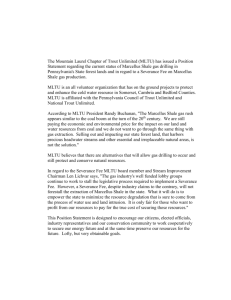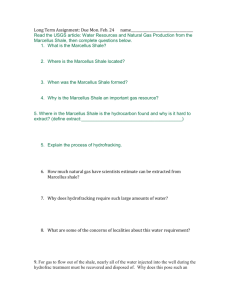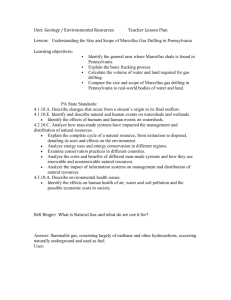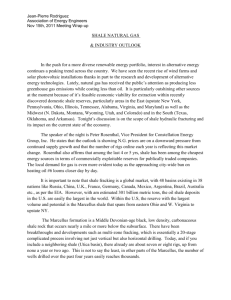In lecture we talked about the importance of mineral
advertisement
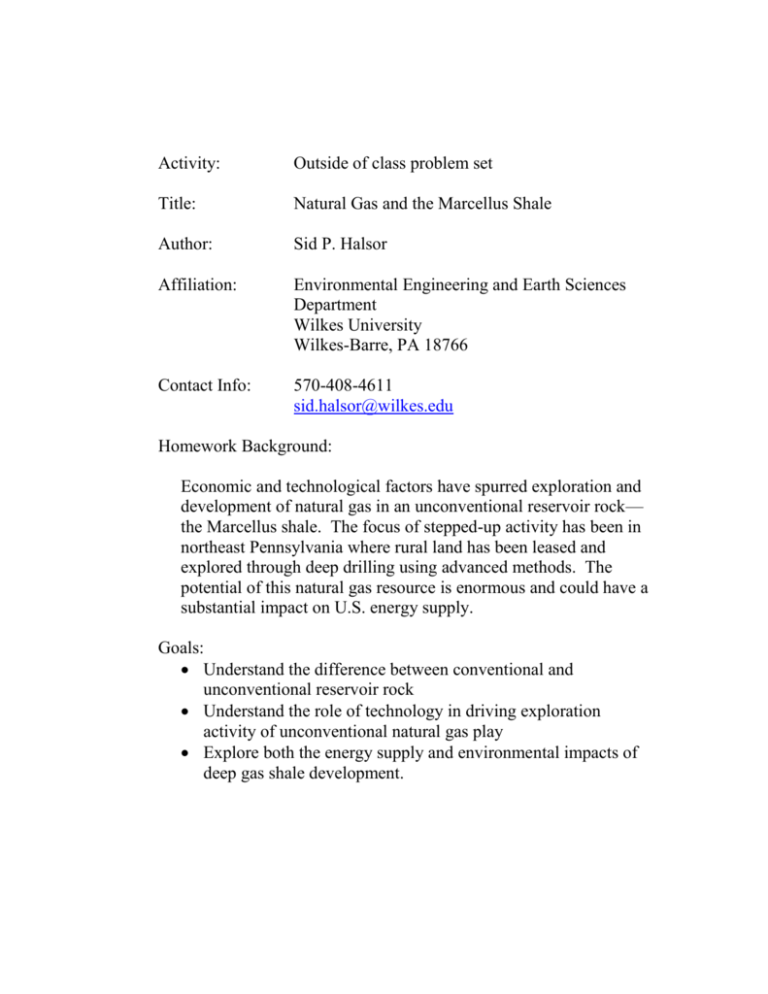
Activity: Outside of class problem set Title: Natural Gas and the Marcellus Shale Author: Sid P. Halsor Affiliation: Environmental Engineering and Earth Sciences Department Wilkes University Wilkes-Barre, PA 18766 Contact Info: 570-408-4611 sid.halsor@wilkes.edu Homework Background: Economic and technological factors have spurred exploration and development of natural gas in an unconventional reservoir rock— the Marcellus shale. The focus of stepped-up activity has been in northeast Pennsylvania where rural land has been leased and explored through deep drilling using advanced methods. The potential of this natural gas resource is enormous and could have a substantial impact on U.S. energy supply. Goals: Understand the difference between conventional and unconventional reservoir rock Understand the role of technology in driving exploration activity of unconventional natural gas play Explore both the energy supply and environmental impacts of deep gas shale development. 2 Name:_________________________ Problem #4 Due April 25th, in class. EES 105 Planet Earth Lab day/time:________________ Natural Gas and the Marcellus Shale Geogal: "When I was a the fitness center the other day I overheard someone say that a friend of theirs had been offered $2,000 an acre by a natural gas company" Geoguy (while examining a hand sample of shale): "Wow, last I heard top dollar was around $1700 an acre. Can you imagine if you owned a couple hundred-acre farm in rural northeast Pennsylvania and you were offered this kind of money. And this is just to lease your land. You’d also get a percentage of the value of any gas that was produced.” Geogal (noting the parting in the shale specimen): "Considering many farmers are just barely making it, I can see that a gas lease offer would be highly attractive. It might be the only way that farmers can survive and keep them from selling their land. After all, family farms are an essential part of our rural landscape." Geoguy (using a grain-size comparator): "But how will gas wells and the production and transmission of gas impact the land? Will a farm still look like a farm?" Geogal: "I’ve heard that advances in technology have reduced the environmental impact of fossil fuel drilling. Still, given the vast area of land that lies above the Marcellus Shale, the landscape would surely be changed. Geoguy (puzzled look on his face): So, how do they get the gas out of a fine-grained impermeable shale anyway?? I. Background. There is much talk about the Marcellus Shale in our region. So much so, that one would think it was a newly discovered mega-source of natural gas that could sustain our country’s needs for decades. In reality, the Marcellus has been known a gas reservoir for more than 75 years. In the late 1800s, natural gas was discovered in shale in western Pennsylvania. By the beginning of the twentieth century, just about every backyard and manufacturing plant within a mile of the Lake Erie shore in Pennsylvania had at least one gas well that kept the house or business reasonable well lighted and heated. The gas wells were shallow, generally less than 1,000 ft. and many were producing from as shallow as 25 or 30ft. The gas supply was often interrupted by variable pressure however, many of the backyard wells are still providing gas to residents of Erie County. 1. Many residents in Pennsylvania have private water wells but imagine having your own natural gas well. Describe the concerns as well as the benefits of having your own natural gas well. II. Marcellus Shale. The shale that defines the Middle Devonian Marcellus Formation is a black, organic-rich, detrital sedimentary rock. The dark color and high organic content are the result of anaerobic decay of marine organisms that accumulated with the finegrained sediment. Organic decay occurred at depth where elevated pressure and temperature converted the carbon into natural gas. Devonian black shales are common to 3 Pennsylvania bedrock and often occur with marginally organic-rich gray shales and siltstones in sequences that can be several thousand feet thick. 2. In conventional reservoirs of fluids (groundwater, crude oil, natural gas), the fluid resides in rocks that are both porous and permeable. Review these terms and give an example of a sedimentary rock that is porous but not permeable. 3. What is the average grain size of shale? 4. Would the intergranular pore space of shale be larger or smaller than intergranular pore space of sandstone? Justify your response. III. Shale as a reservoir rock. Black, organic-rich shale is a conventional source rock for crude oil and natural gas but an unconventional reservoir rock. Crude oil and natural gas form from a carbon-rich source at depth then, due to their lower density compared to the surrounding rock, the fluids rise up and accumulate in porous and permeable rock (a reservoir) that is capped by an impermeable layer. The impermeable cap prevents the accumulated oil and/or gas to be dispersed through the crust. In conventional exploration, deep wells are drilled through the cap and accumulated crude oil and/or natural gas is extracted from the reservoir. 5. Why would shale, like the Marcellus, be considered an unconventional reservoir for natural gas? IV. The push to explore and develop the Marcellus shale. Rising natural gas prices during the turn of the current century coupled with technological advances spurred interest in the Marcellus shale in northeastern Pennsylvania. Although the thickness of the Marcellus shale is greater in eastern Pennsylvania, the depth to the shale is also greater. Most of the exploratory and development gas wells in eastern Pennsylvania are drilled to depths ranging between 5,000 and 8,000 ft. 6. If it costs a gas drilling company about $150 per foot to drill a vertical gas well, how much does it cost to drill a 7,000 ft. vertical well? 7. An average vertical gas well might produce 45,000 cubic feet per day. If the wellhead (top of the well before it flows into a pipeline for distribution) price for natural gas is $7.50 per thousand cubic feet, how many years will it take a gas company to recover its cost to drill a 7,000 ft well? V. Horizontal drilling and hydraulic fracturing. New drilling and stimulating techniques have made the Marcellus shale in northeastern Pennsylvania a viable target for gas extraction. Horizontal drilling allows a vertical well to turn and penetrate a layer of rock. This allows a much greater volume of gas-bearing rock to be intersected by a drill. Furthermore, hydraulic fracturing (“fracking”) is a technique that enhances the recovery of gas and/or crude oil. This technique involves pumping a water-based fluid and sand into a formation under high pressure. The pressure induces cracks in the rock and the sand helps prop open the cracks. Horizontal drilling and hydraulic fracturing triples the cost of drilling a well. 4 VIEW A 5-MINUTE SIMULATION OF THE HORIZONTAL DRILLINGHYDRAULIC FRACKING PROCESS AT http://www.pamarcellus.com/ SELECT DRILLING PROCESS VIDEO 6. How are shallow aquifers protected from contamination by the drilling process and subsequent extraction of natural gas? 7. What is meant by a “tight gas reservoir”? 8 What is the key effect of “perfing” and “fracking” a horizontal well? Be clear in your explanation. VI. Environmental issues associated with deep gas well drilling. Any process that extracts a natural resource from the earth’s crust impacts the environment (“we can’t get something for nothing”). Although much needed regulations emplaced over the last several decades have lessened the impacts, they have not eliminated them. Conventional vertical well drilling environmental impacts include surface disturbance (access and drilling operation set up, disposal of rock cuttings carried out of the well by a mixture of clay and water, i.e. “drilling mud”, emplacement of infrastructure to move gas into a pipeline network) and “down hole” preventative measures (contamination of groundwater aquifers, management of saline formation waters that can carry toxic chemical compounds). Do these environmental impacts apply to unconventional deep gas well drilling in northeast Pennsylvania? Review the following articles: 1) http://www.extension.org/pages/Deepwell_Natural_Gas_Drilling_a_Concern_for_State's_Water_Quality 2) http://www.wilkesbeacon.com/news/wilkes-research-project-analyzes-marcellusshale-in-nepa-1.853386 9. List and describe three major environmental impacts of deep gas well drilling in northeastern Pennsylvania: 1. 2. 3. VII. Energy impact of natural gas in Marcellus shale. By estimating the volume of the Marcellus shale and its carbon content, geoscientists can determine the total amount of natural gas reserved in the formation. Current estimates of the volume of gas in the Marcellus shale range from 168 to 516 trillion cubic feet. Of this total, about 10% is considered recoverable given the current economic climate and available technology. 10. U.S. natural gas consumption in 2008 was 23,208,677 cubic feet. The volume of currently recoverable gas from the Marcellus shale is equivalent to how many years at our current annual consumption rate? Online Resources: PA DEP Marcellus Shale http://www.dep.state.pa.us/dep/deputate/minres/oilgas/new_forms/marcellus/marcellus.htm Earthworks: Shale Gas http://www.earthworksaction.org/pubs/OGAPMarcellusShaleReport-6-12-08.pdf



